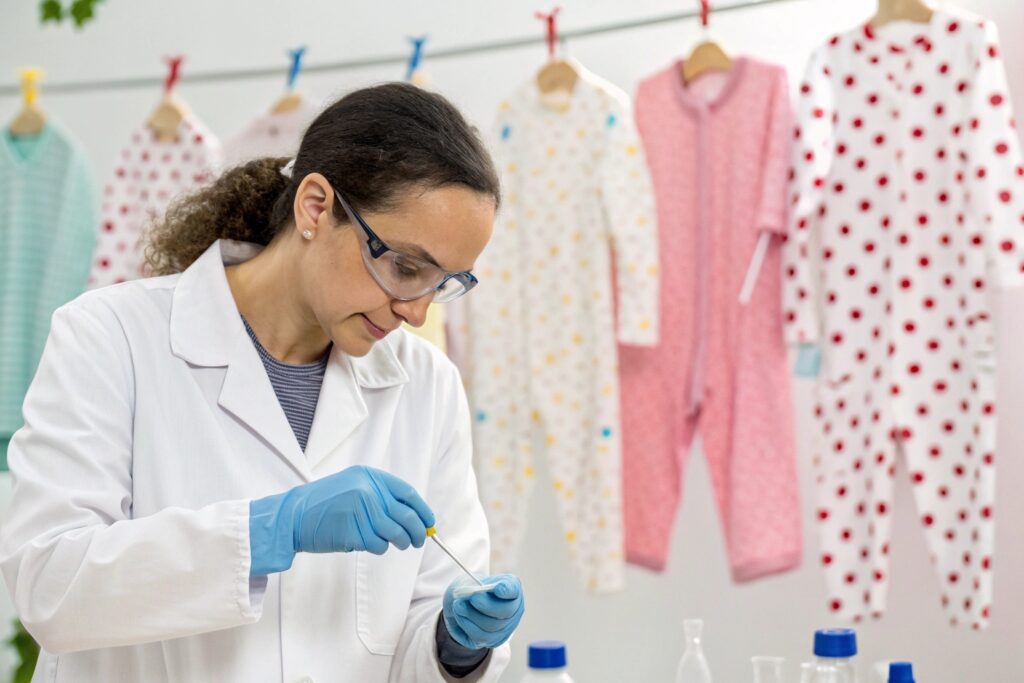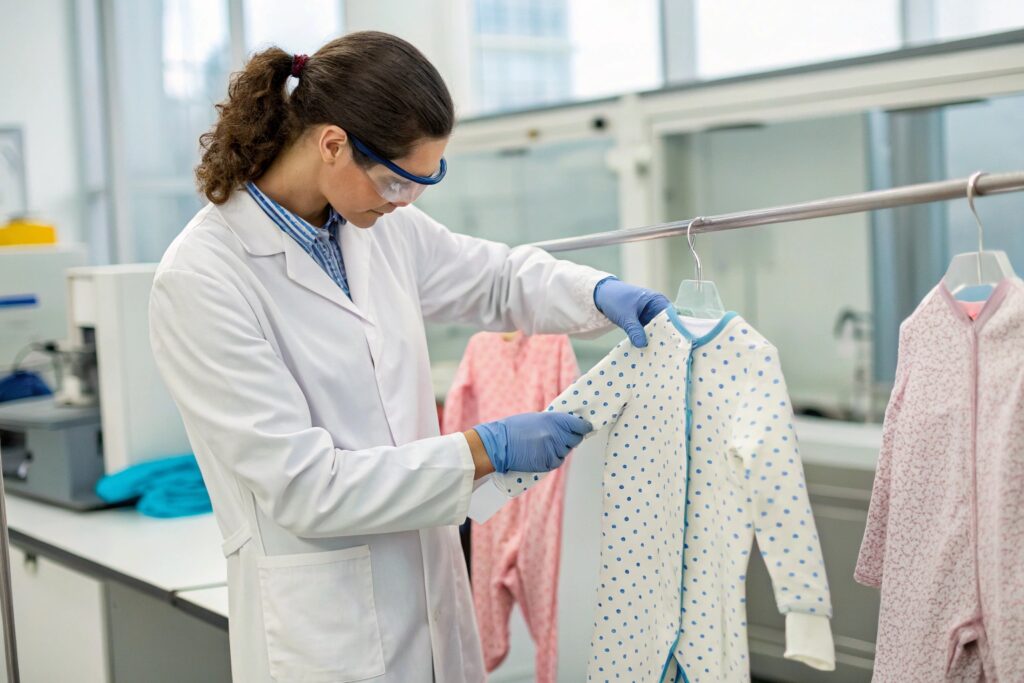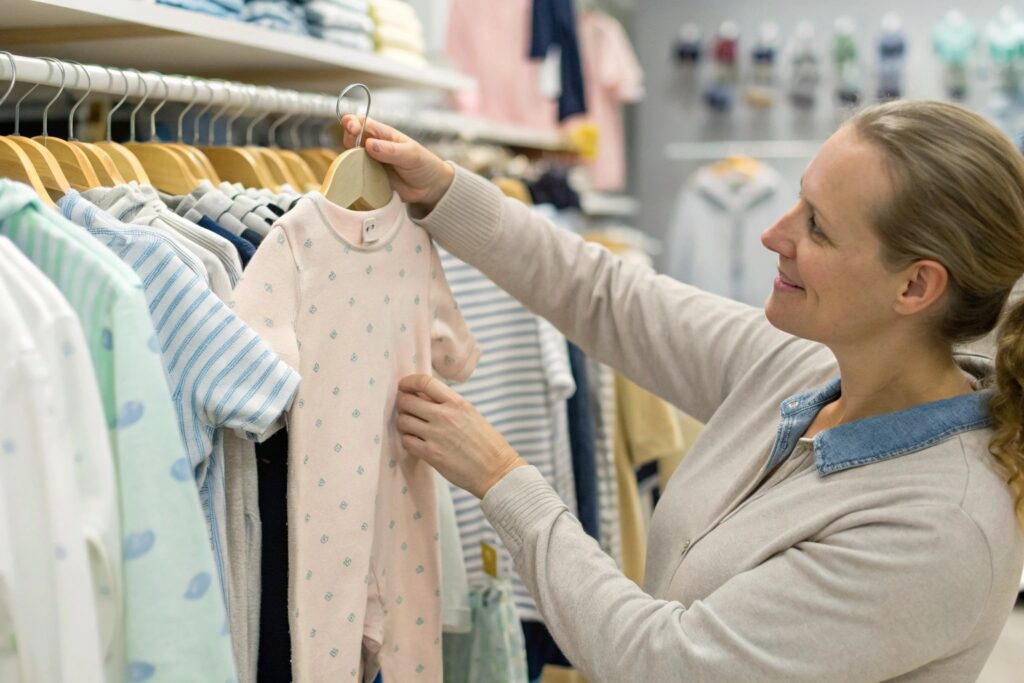The best babywear brands don’t just sell clothes—they build trust, comfort, and confidence with every stitch. What sets them apart happens long before a product hits the shelf.
Top babywear brands stand out by investing in fabric safety, skilled craftsmanship, detailed quality control, and ethical, sustainable production practices.
Let’s explore how leading babywear companies produce garments that parents return to—and recommend.
How Top Brands Prioritize Fabric Safety and Testing?
Softness is expected. But the best brands go further—testing every fabric, thread, and snap to meet global safety standards.
Top babywear brands use certified fabrics like OEKO-TEX® and GOTS, and regularly test for chemicals, shrinkage, pH levels, and colorfastness.

What top brands test before production:
| Test Type | What It Ensures |
|---|---|
| OEKO-TEX® / GOTS certification | Fabric is free from harmful chemicals |
| Colorfastness to saliva/sweat | Dyes won’t bleed when babies drool or chew |
| Shrinkage test | Sizing remains accurate after washing |
| pH balance test | Fabric matches baby skin sensitivity |
| Snap/button strength test | Avoids choking hazards from loose hardware |
Fabrics must pass these tests consistently across production runs. Brands like Fumao include full compliance folders with every shipment.
Why it matters: Parents trust labels that prove garments are tested—not just described as "safe" or "natural."
Why Leading Brands Invest in Skilled Craftsmanship?
Premium babywear starts with people—especially those behind the machines. High-end brands know quality is in the details.
Top brands hire trained babywear sewers who specialize in soft seams, flat stitching, and secure fastenings tailored for infant comfort and safety.

Craftsmanship details that matter:
| Sewing Standard | Why It’s Important |
|---|---|
| Flatlock or coverstitch seams | Prevent friction or bulk on baby skin |
| Enclosed or bound seams | Hide thread ends, reduce irritation |
| Reinforced snap zones | Prevent rips and weak closures |
| Pattern alignment | Clean, consistent garment shapes |
| Tagless labeling | Avoids neck irritation in newborns |
At Fumao, we train sewing teams specifically on babywear techniques, ensuring each garment meets the softness and durability expected from premium brands.
Better craftsmanship means fewer defects, longer-lasting products, and lower return rates.
What Quality Control Steps Set Premium Babywear Apart?
Even with great fabrics and skilled labor, final quality depends on tight inspection. Premium brands don’t skip this step.
Leading babywear brands enforce 3-stage quality control: pre-production checks, in-line inspection, and post-production review—plus lab testing when needed.

Sample quality control process:
| Stage | Key Checks |
|---|---|
| Pre-production sample | Fit, color, trim safety, label accuracy |
| Inline QC (during sewing) | Seams, trims, size specs checked per batch |
| Final inspection | Measure, pull test, stain check, packaging |
| Lab testing (optional) | Confirms pH, shrinkage, colorfastness |
Premium brands also review:
- Stitch count per inch (higher = stronger)
- Snap/button placement accuracy
- Fold and packaging alignment
- Lot number or tracking label placement
Consistent QC builds brand reputation and earns shelf space in competitive markets.
How Ethical and Sustainable Practices Build Trust?
More than ever, buyers and retailers care about where—and how—babywear is made. Ethical production isn’t optional for premium positioning.
The best babywear brands ensure ethical labor, transparent sourcing, and low-impact production, often backed by certifications like GOTS, BSCI, and GRS.

What ethical production includes:
| Practice | Why It Builds Trust |
|---|---|
| Fair labor practices | Keeps supply chain responsible |
| Certified organic fibers | Aligns with modern parenting values |
| Eco-friendly dyeing | Protects baby skin and environment |
| Low-waste production | Reduces landfill and unsold inventory |
| Sustainable packaging | Compostable bags, recycled tags |
Ethical factories often use solar energy, water recycling, and batch-level transparency to meet sustainability goals.
Brands that show behind-the-scenes production or publish sustainability reports gain loyalty from conscious consumers—especially millennial and Gen Z parents.
Conclusion
The best babywear brands succeed because they care—from fiber to finish. They use tested fabrics, skilled labor, layered QC, and sustainable practices to ensure each garment is soft, safe, and trusted by parents around the world.










